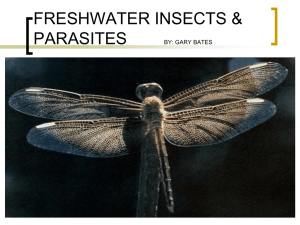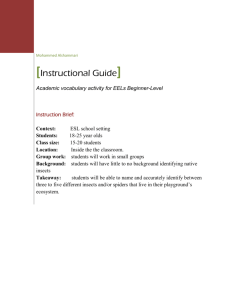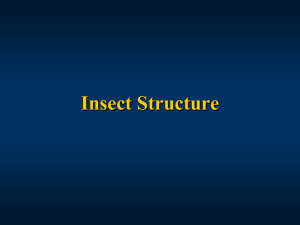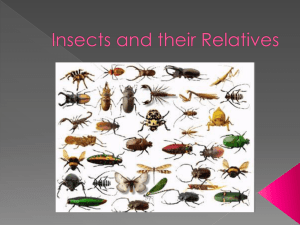“Insect-O-Rama” – Aquatic Insects
advertisement
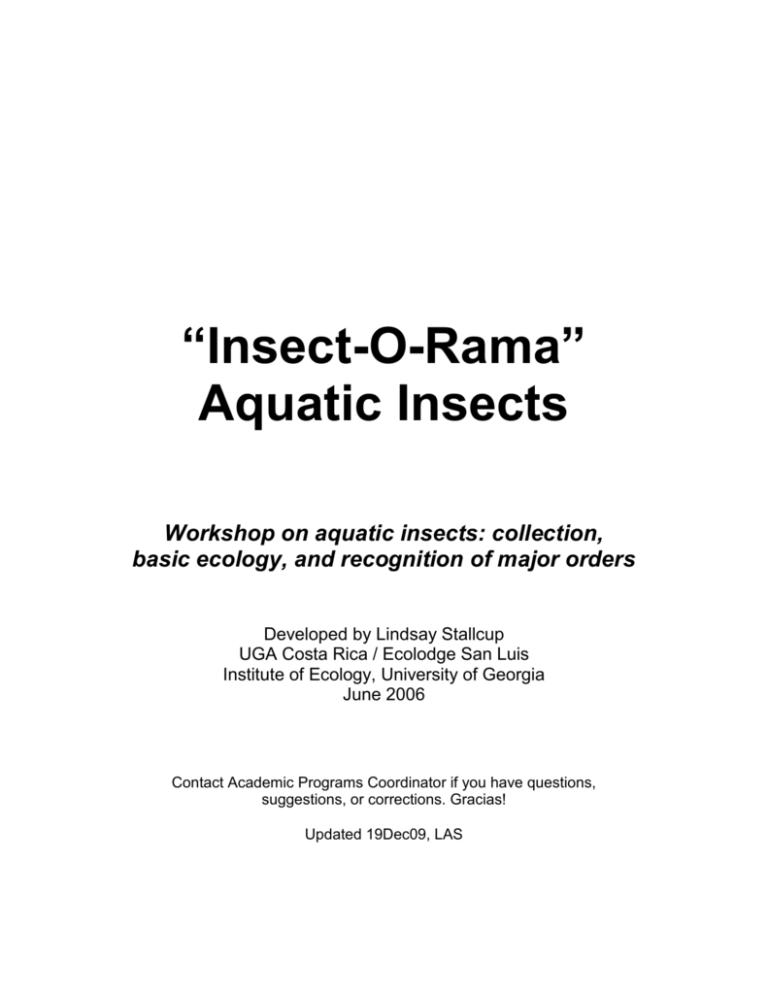
“Insect-O-Rama” Aquatic Insects Workshop on aquatic insects: collection, basic ecology, and recognition of major orders Developed by Lindsay Stallcup UGA Costa Rica / Ecolodge San Luis Institute of Ecology, University of Georgia June 2006 Contact Academic Programs Coordinator if you have questions, suggestions, or corrections. Gracias! Updated 19Dec09, LAS “Insect-O-Rama” – Aquatic Insects Equipment needed Take to field: D-frame nets, Surber sampler, white plastic bowls or pans for collecting/sorting Vials and containers for sorting Forceps, hand lenses Have in lab: Alcohol for preserving & viewing samples Microscopes & lights Outline of Workshop Part I. How do we collect aquatic insects? A. Review methods for collecting aquatic insects - D-frame / kick nets: place straight metal part of net frame on stream bottom and disturb area just upstream of the net (qualitative sample) - Surber sampler: place frame of sampler on stream bottom and disturb the substrate within the frame. This is the same idea as the kick net, but gives you a known area (more quantitative) - Pick up rocks and remove insects using forceps, or scrub carefully with a brush - Sweep surface of pools or ponds to collect water striders and other surface-dwelling insects B. Review different habitats in which students might collect insects – streams & rivers (riffles and pools); wetlands; bromeliads; water tanks; anywhere else water tends to collect Part II. Field collection of insects A. Distribute nets, Surber sampler, plastic bowls/pans, vials, and forceps to students for collecting B. Take students into field for collection of insects. Possible sites close to the Ecolodge include: Streams: Rio Alondra & tributary where they cross the road, past Cabina gate/entrance Rio San Luis, could be done on hike to waterfall Wetlands: Laguna/pond on left side of road after passing entry road to Cabinas Part III. Insects – overview of ecology, morphology, and common orders A. B. C. D. E. What is an insect? Basic overview of taxonomy; characteristics shared by all insects Why do we care about aquatic insects? Ecological roles & importance Feeding habits – functional feedin groups Life cycle – metamorphosis Overview of some common orders – in order from most primitive to most advanced: Hemimetabolous Ephemeroptera Odonata Plecoptera Hemiptera Holometabolous Megaloptera Coleoptera Trichoptera Diptera For each order, give the following: 1. metamorphosis – hemi (“incomplete”) or holo (“complete”) 2. meaning of name (ex: Coleoptera = “sheath wing”) 3. common names, examples 4. mouthparts & feeding habits 5. habitats 6. identifying characteristics Part IV. Identifying & grouping insects that have been collected A. Have students work in groups of 2-3 to sort insects according to order. Focus should be on visual identification and on getting orders – not on getting things to family, species, etc. It’s okay to make a category for “unknowns.” Instructor can circulate and check accuracy and answer questions. B. When small groups have finished, combine groups to get a “class collection,” labeling the orders and putting “like species” together. C. Class collection can be compared with existing collections. This should be saved until the END of the activity – idea is for students to rely on their own classifications first, then compare later. What is an insect? What do we mean when we call something an insect? All forms of life are classified by taxonomists according to the following scheme of classification. Each category is called a “taxon.” Here is an example of how insects would be classified: Domain: Eukaryota Kingdom: Animalia (animals) Phylum: Arthropoda (arthropods) Class: Insecta (insects) Order: we will be covering the major orders of aquatic insects today Family Genus Species Basic characteristics of insects. All insects have the following during at least some life stage: - head, thorax, and abdomen - 3 pairs of legs - 2 pairs of wings - 2 antennae A. Why do we care about aquatic insects? Aquatic insects can be found anywhere there’s water: streams, rivers, wetlands, drains, etc. Aquatic insects are often the larvae of terrestrial adults, although some are always aquatic. Aquatic insects play important ecological roles: - They are a major food item for many birds, fish, frogs, bats, etc. Even if they’re not a food item in the aquatic life stages, they may be as winged/terrestrial adults. - Abundance & diversity of aquatic insects can tell us a lot about ecosystems: - Different aquatic insects have different tolerance levels to pollution and/or habitat alteration. - Some aquatic insects are sensitive to pollution: if a stream or river becomes polluted, they will die or move elsewhere. - Others aquatic insects are tolerant of pollution, meaning they can survive in polluted water. - Aquatic insects also require suitable habitat, including a good selection of rocks, logs, silt and plants in and along the edge of the river or stream. If suitable habitat is not present, aquatic insects will not be able to survive in that location. C. Feeding habits All aquatic insects fit into one or more of these “functional feeding groups,” depending on what and how they eat: - Filterers feed on organic matter in water column (algae, particulate organic matter, detritus) - Collectors consume small particles of organic matter from the sediment (algae, POM, detritus) - Shredders are herbivores that consume mostly leaves. They are important in breaking up leaves into smaller particles, which can then be consumed by filterers and collectors. - Scrapers are also herbivores. They feed mostly on algae, which they scrape off rocks or wood. - Predators eat other aquatic insects or other small invertebrates, or sometimes even small fish. D. Life cycle – metamorphosis Metamorphosis refers to a major change of form or structure during development. Metamorphosis is one of the key reasons why insects are so successful. Many insects have immature stages with completely different habitats from the adults. This means that insects can often exploit valuable food resources while still being able to disperse into new habitats as winged adults. The potential for adaptation and evolution is greatly enhanced by metamorphosis. Within the class Insecta, there are 3 subclasses: Ametabola – only 2 orders, won’t talk about today Hemimetabola Holometabola The “older” or more primitive condition is hemimetabolous, or “incomplete metamorphosis.” Hemimetabolous insects do not have a pupal stage. The general appearance of the immature stages is somewhat similar to that of adults, although there may be some dramatic differences in lifestyle. Only adult insects are able to reproduce, and only adult insects have functional wings (in those species that have wings). The immature stages of these insects are generally called nymphs rather than larvae. Holometabolous, or “complete metamorphosis”: Many of the major insect orders have a typical life cycle which consists of an egg, which hatches into a larva which feeds, molts and grows larger, pupates, then emerges as an adult insect that looks very different from the larva. These insects are often called 'Holometabolous', meaning they undergo a complete (Holo = total) change (metabolous = metamorphosis or change). Typical life cycle of a holometabolous Insect, such as an ant (egg, larva, pupa, adult) Typical life cycle of a hemimetabolous insect such as a dragonfly (egg, various instars/immature phases, adult) Order Ephemeroptera Metamorphosis Incomplete Meaning of name From the Greek "ephemera" meaning short-lived, and "ptera" meaning wings – reference to short lifespan of most adults. Common names Mayflies Mouthparts and feeding habits Scrapers, collectors, filterers Habitats Various habitats in streams, rivers, ponds Identifying characteristics Immatures: - Antennae short and bristle-like - 4-9 pairs of leaf- or fan-like gills along sides of abdomen - Three long filaments at rear of abdomen (rarely two) Example of immature mayflies (naiads) Example of adult mayfly Facts about Ephemeroptera: - Many northern lakes and rivers in U.S. & Europe support large populations of mayflies. - In some mayfly species, summer emergence of winged stages is a sudden and dramatic event that occurs almost simultaneously throughout the entire population. - Mayflies are a favorite bait of fishermen, and many popular fishing "flies" resemble mayflies. - The immature stages of mayflies are aquatic. They generally live in unpolluted habitats with fresh, flowing water. They can be "ecological indicators" of good water quality and are an important source of food for fish and other aquatic wildlife. - The life cycle of mayflies is unique among hemimetabolous insects in that larvae emerge into a shortlived, usually sexually immature, subimago or sub-adult stage prior to molting into the sexually mature adult. The mayfly adult typically survives for only a few hours, just long enough to mate and lay eggs. - Females lay their eggs by flying low over the water surface and dipping an extruded egg sac into the water. In some species that inhabit swift flowing water, the female will crawl under the water surface to lay her eggs directly on submerged rocks. The duration of the egg stage can range from a few days to a number of months. Larvae undergo a number of instars (growth stages) depending on species and conditions. Order Odonata Metamorphosis Incomplete Meaning of name From Greek “odonto” – meaning tooth Common names Two suborders: Dragonflies (suborder Anisoptera) Damselflies (suborder Zygoptera) Mouthparts and feeding habits Predators Habitats All types of standing or running water; many live in vegetation or debris. Some can live in tree holes or bromeliads. Identifying characteristics All Odonata have a hinged labium ending in sharp jaws Dragonflies have a robust body ending in three sharp spines Damselflies have a long, slender body and three flat, leaf-like gills at rear of abdomen (looks like a tail) Spanish name Libélula Facts about Odonata: - Ancient insects that have been around since before the age of the dinosaurs. Some Odonate fossils from the Carboniferous period had wingspans of over a meter! - Some odonates can shoot out their labium and catch prey in only 25 milliseconds. They feed on other aquatic insects, and even small fish and tadpoles! - Many adult male dragonflies establish and defend territories along the perimeter of a lake or stream. Females will mate only with males that hold a territory. - Male damselflies (and perhaps some dragonflies) have a special flagellum associated with the copulatory organ that can reach into a female's body and remove sperm deposited by another male in a previous mating. Example of dragonfly adult and immature Example of damselfly adult and immature Order Plecoptera Metamorphosis Incomplete Meaning of name From Greek "pleco" meaning folded and "ptera" meaning wing, refers to the pleated hind wings which fold under the front wings when the insect is at rest Common names Stoneflies Mouthparts and feeding habits Scrapers/grazers (algae) Important as shredders in North America A few (2 families) are predators of other small aquatic insects Habitats Under stones/rocks Usually in clean, fast-moving, well-aerated water Identifying characteristics: - Two cerci (“tails”)- usually long & multi-segmented Antennae long, filiform Body flattened, legs widely separated Gills look like "tufts" behind head, at base of legs, or around anus Each segment of thorax is covered by a large dorsal sclerite Facts about Plecoptera - Stoneflies require clean, well-oxygenated water to survive. They are extremely sensitive to water pollution and are used by ecologists as indicators of water quality. - Stoneflies are also an important source of food for game fish (e.g., trout, bass) in cold mountain streams. - Stoneflies are most abundant in cool, temperate climates – not especially common/diverse in in Costa Rica (only 1 genus) - Most adults are short-lived and do not have functional mouthparts - Immature stoneflies look very much like the adults with the exception of the wings, which are not present in the nymph. Example of Plecoptera immature Order Hemiptera Metamorphosis Incomplete Meaning of name Hemiptera means "half wing" – part of the first pair of wings is toughened and hard, while the rest of the first pair and the second pair are membranous Common names True bugs Mouthparts and feeding habits Piercing/sucking mouthparts Nearly all are predators of other aquatic organisms Habitats On the surface of fresh water, beneath surface, near shorelines Identifying characteristics - Leathery forewing (hemelytra) Mouth shaped like a sucking beak (proboscis) Wings lie flat on the back at rest, forming an "X" or a triangle Antennae slender with 4-5 segments Facts about Hemiptera - Water striders are common in quiet areas of rivers, lakes and ponds where they can be seen walking over on the water surface. Water boatman are common in most water types. They range in size from 3 mm to about one cm. Backswimmers are usually not as common but by no means rare. They are about one cm long and have a distinctive keeled back and swim upside down. - The immature stages and adults are very similar in structure except for the presence of wings in the adult. However, some adult forms of the families Gerridae and Vellidae may be wingless. - Some of the larger species such as the "giant water bug", Lethocerus americanus, will feed on small fish and tadpoles. The forelegs in this creature are used to grasp the prey and the beak injects digestive juices to kill the prey. The internal tissues of the prey are liquified by the digestive juices and sucked out. - The life cycle of most water bugs involve over-wintering adults. Eggs are laid in the early spring and the larvae develop through the summer months. Some, however, have over-wintering eggs. - A number of hemipteran families, Gerridae, Microvellidae, and Mesovellidae are able to walk on the water surface due to hydrofuge hairs on their legs that prevent them from breaking through the surface tension, hence the common name of "water striders". Water strider Water boatman Backswimmer Giant water bug (Belastomatidae) Order Megaloptera Metamorphosis Complete Meaning of name From the Greek word "neuron" meaning sinew and "ptera" meaning wings. The modern English translation "nerve-wings" is appropriate because of extensive branching in wing veins of most Neuroptera. Common names Two families: Corydalidae (Dobsonflies) and Sialidae (alderflies) Mouthparts and feeding habits Chewing mouthparts. Predators! (other insect larvae, crustaceans) Habitats Under stones or submerged vegetation Identifying characteristics Elongate, moderately flattened larvae Lateral abdominal filaments Anal prolegs (Corydalida) or caudal filament (Sialidae) Some may have trachael gills (subfamily Corydalinae) Examples of Megaloptera larvae Order Coleoptera Metamorphosis Complete Meaning of name From the Greek words "koleos" meaning sheath and "ptera" meaning wings, refers to the modified front wings which serve as protective covers for the membranous hind wings Common names Beetles and weevils Mouthparts and feeding habits Strong mandibulate mouthparts; diets varied Habitats Varied – terrestrial, aquatic, burrowing, etc. Identifying characteristics Elytra!! – hardened forewings – defining characteristic Front wings (elytra) are hard and serve as covers for the hind wings; meet in a line down the middle of the back Hind wings large, membranous, folded beneath the elytra Chewing mouthparts (sometimes at tip of beak or snout) Tarsi 2- to 5-segmented Spanish name Abejón (beetle) Facts about Coleoptera - Coleoptera is the largest and most diverse order in the class Insecta. Coleoptera is also the largest order in the animal kingdom. It includes 40% of all insects and nearly 30% of all animal species. - Beetle larvae often look very different from adults! Larvae are much more variable in form than adults. Some have large fang-like mandibles others have chewing mouth parts. The legs can be reduced or well developed. The abdomen can have lateral projections on it or dorsal ornamentation. Size can vary as much as the size as the adult (2 mm to 3 cm) - Of over 250,000 species of Coleoptera, about 5000 species have aquatic stages. Even so the beetles are one of the most diverse freshwater macroinvertebrate groups. - Coleoptera are found in all types of aquatic habitats but the diversity is highest in lentic (standing) water. - The Gyrinidae, or “whirligig beetle,” is one of the most conspicuous and curious beetles. Adults are usually seen in groups at the water surface swimming in a rapid and erratic manner. The adult eyes are divided into upper and lower portions. This marvelous adaptation allows the beetles to live at the water surface and be able to see above and below without any distortion caused by the air/water interface. Whirlygig beetle larvae and adult Halipidae larva and adult Riffle beetle (Elmidae) Order Diptera Metamorphosis Complete Meaning of name From the Greek words "di" meaning two and "ptera" meaning wings – true flies have only a single pair of wings. Common names True flies – include mosquitoes, blackflies, crane flies, midges, etc. Mouthparts and feeding habits Sucking mouthparts – scavenger (dead organic matter), predators, or parasites. Immatures: Aquatic, semi-aquatic, or moist terrestrial. Found in soil, plant/animal tissue, carrion/dung. Habitats Adults: wide range of habitats, enormous variation in appearance and lifestyle. Identifying characteristics Facts about Diptera: - Mosquitoes (family Culicidae) are tolerant of standing water and can be harmful to humans and livestock (bites, transmission of disease, etc.) - Blackflies (family Simuliidae) are the vector for river blindness. Larvae are filterers, are most commonly found in flowing water, and have fans that they use to capture detritus. They are extremely common in San Luis – they’re the ones that leave a small red dot when they bite you! - Some of the interesting adaptations flies have used to colonize the aquatic habitat include breathing tubes, silken tunnels, and ventral suction cups. Example of breathing tube, an adaptation for aquatic life & living in low-oxygen environments Mosquito larva Blackfly (Simuliidae) larva Cranefly (Tipuliidae) larva and adult Midge (Chironomidae) larva Order Trichoptera Metamorphosis Complete Meaning of name From Greek "trichos" = hair and "ptera" = wings, refers to the long, silky hairs that cover most of the body and wings. Common names Caddisflies Mouthparts and feeding habits Herbivores, collectors, filterers, or predators Habitats Various habitats Identifying characteristics Caterpillar-like body; abdomen usually enclosed in a case made of stones, leaves, twigs, or other natural materials. Head capsule well-developed with chewing mouthparts Thread-like abdominal gills usually present in case-makers One pair of hooked prolegs often present at tip of abdomen Facts about Trichoptera - Trichoptera are one of the most diverse orders of aquatic insects, with over 7,000 species worldwide. - Caddisfly larvae may serve as food for fish and other aquatic vertebrates. Fishermen often gather them for use as bait for trout and other game fish. - Caddisflies are found in all types of aquatic habitats. The majority are intolerant of pollution and valuable tools for monitoring organic and chemical contamination of habitats. - Females usually lay eggs directly into the water either singly or in masses. Some species lay their eggs above the water on overhanging vegetation while those inhabiting temporary ponds lay their eggs in dry pond basins. - The larval stage is the only real significant feeding stage. Most species are omnivorous. The larvae scrape food off surfaces or shred decaying debris with their mandibles. - Caddisflies have diverse habitats and feeding behaviors. The majority fall into one of the following groups: (1) Case-building caddisflies build case of sand, small pebbles, leaves, or twigs. The case is held together by silk produced by larvae and is used for camouflage and protection from predators. (2) Net-spinning larvae produce silk and construct nets, which are used to trap detritus and other organic matter from the water column. Caddisfly nets can be seen by looking closely at rocks in streams. (3) Free-living caddisflies do not construct nets, retreats, or cases. Examples of caddisfly cases Caddisfly cases with larvae Example of a caddisfly


